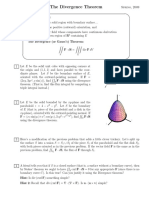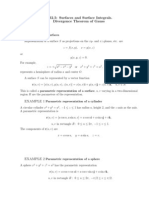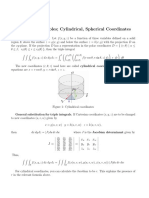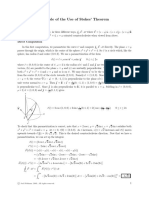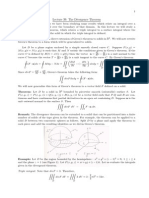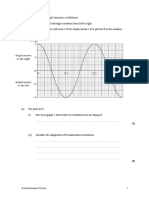Ivan Dumitru Mircea
Uploaded by
Tudor CiotloșIvan Dumitru Mircea
Uploaded by
Tudor Ciotloș2013-eng
Ivan Dumitru Mircea
Surface Integrals of the First Kind Wildhoney
Let M R
2
be a mesurable set and let S : M R
3
an
injective parameterized surface of C
1
class,
S :
_
_
_
x = x(u, v)
y = y(u, v)
z = z(u, v)
, (u, v) M.
Consider the vector feld r : M E
3
,
r (u, v) = x(u, v) + y(u, v) + z(u, v)
associated to S. Suppose also that S is nonsingular, i.e.,
r
u
r
v
= 0 pe M. Let D M be a rectangle,
D = {(u, v) | u
0
u u
0
+ u, v
0
v v
0
+ v}.
w
First let us calculate the area of the parallelogram defned by
the vectors
r (u
0
+ u, v
0
) r (u
0
, v
0
), r (u
0
, v
0
+ v) r (u
0
, v
0
).
We have:
arie(S(D))
(r (u
0
+ u, v
0
) r (u
0
, v
0
)) (r (u
0
, v
0
+ v) r (u
0
, v
0
))
T.medie
r
u
(u
0
, v
0
)u r
v
(u
0
, v
0
)v,
hence
arie(S(D)) r
u
r
v
uv.
w
Thus, the following defnition is justifed.
D 1 The area of the surface S(M) is defned by
area(S(M)) :=
__
M
r
u
r
v
dudv.
D 2 The differential d := r
u
r
v
dudv is called the element
of area.
From
r
u
r
v
=
u
y
u
z
u
x
v
y
v
z
= A + B + C,
where
w
A =
u
z
u
y
v
z
, B =
u
x
u
z
v
x
, C =
u
y
u
x
v
y
,
we get
d =
_
A
2
+ B
2
+ C
2
dudv.
From
r
u
r
2
= r
u
2
r
v
2
sin
2
(
u
, r
v
)
= r
u
2
r
v
2
r
u
2
r
v
2
cos
2
(r
u
, r
v
)
= r
u
2
r
v
2
(r
u
r
v
)
2
,
with:
E = r
u
2
= x
u
2
+ y
u
2
+ z
u
2
F = r
u
r
v
= x
u
x
v
+ y
u
y
v
+ z
u
z
v
G = r
v
2
= x
v
2
+ y
v
2
+ z
v
2
,
we obtain
d =
_
EGF
2
dudv.
w
If S possesses an explicit representation z = z(x, y), with
p :=
z
x
=:
x
z,
q :=
z
y
=:
y
z,
we get
d =
_
1 + p
2
+ q
2
dxdy.
w
Ex 3 Find the element of area on the surface of the sphere of
radius R,
S :
_
_
_
x = Rsin cos
y = Rsin sin
z = Rcos
, [0, 2), [0, ].
By using the formulas:
E = x
2
+ y
2
+ z
2
,
G = x
2
+ y
2
+ z
2
,
F = x
+ y
+ z
,
we get:
E = R
2
(sin
2
sin
2
+ sin
2
cos
2
) = R
2
sin
2
,
G = R
2
(cos
2
cos
2
+ cos
2
sin
2
+ sin
2
) = R
2
,
F = R
2
(sin sin cos cos + sin sin cos cos ) = 0,
hence d =
_
EGF
2
d d = R
2
sin d d. 4
Let f be a real continuous function defned on a domain
containing S(M).
D 4 The number
__
S
f(x, y, z) d
:=
__
M
f(x(u, v), y(u, v)z(u, v)) r
u
r
v
dudv.
is the surface integral of f with respect to area on S .
Rem 5 The surface integral with respect to area is also called
surface integral of the frst kind .
w
Note that:
arie(S) =
__
S
d.
Similarly, if r = x +y +z is the position vector of a point
on S, then the position vector r
G
of the centroid G of S is
given by
r
G
=
__
S
r d
__
S
d
.
w
Ex 6 Find the centroid of the hemisphere
S: x
2
+ y
2
+ z
2
= R
2
, z 0.
We have
S :
_
_
_
x = Rsin cos
y = Rsin sin
z = Rcos
, [0, 2), [0,
2
].
From symmetry reasons, we have: x
G
= 0, y
G
= 0. We get:
z
G
=
__
S
z d/
__
S
d,
__
S
z d = R
3
_
2
0
d
_
/2
0
sin cos d = R
3
,
__
S
d = R
2
_
2
0
d
_
/2
0
sin d = 2R
2
,
z
G
=
R
3
2R
2
=
R
2
. 4
Surface Integrals of the Second Kind
Let n = n(A) =
r
u
r
v
r
u
r
be the unit vector normal to S at
the point A S(M).
n
S
D 7 If for any closed path on S(M), the function A n(A)
is continuous, than we say that the surface S is oriented , or
has two sides .
Let S : M R
3
an oriented surface. We fx an orientation on
S by choosing a vector normal
n =
r
u
r
v
r
u
r
.
Let us consider a continuous vector feld v = P +Q +R
defned on a domain including S(M).
D 8 The number
S
(v ) :=
__
S
v n d
is called the fux across the surface S .
The notation d := nd is often used. w
We note that:
S
(v ) =
__
M
v
r
u
r
v
r
u
r
u
r
v
dudv
=
__
M
v (r
u
r
v
) dudv =
__
M
P Q R
x
u
y
u
z
u
x
v
y
v
z
dudv,
hence
S
(v ) :=
__
S
v n d =
__
M
P Q R
x
u
y
u
z
u
x
v
y
v
z
dudv 4
Ex 9 Calculate the fux of the vector feld v = k
across the positive side of the sphere
S :
_
_
_
x = Rsin cos
y = Rsin sin
z = Rcos
, [0, 2), [0, ].
We have:
n = sin cos + sin sin + cos , v n = cos ,
d = R
2
sin dd,
S
(v ) =
__
S
v n d
= R
2
_
2
0
d
_
0
sin cos d = 0. 4
The Kelvin-Stokes Formula
T 10 (G. G. STOKES) The Stokes Formula,
_
S
v dr =
__
S
(rot v )n d.
relates the surface integral of the curl of a vector feld v over
a surface S to the line integral of the vector feld v along its
boundary S.
Rem 11 The Stokes Formula can be rewritten in the form
_
S
P dx + Qdy+Rdz =
__
S
_
Q
x
P
y
_
dxdy
+
_
R
y
Q
z
_
dydz+
_
P
z
R
x
_
dzdx.
w
If (S) is a domain included in the xOy plane, we obtain:
dz = dydz = dzdx = 0,
and we reobtain the Green Formula. w
The Volume Integral
Let R
3
be a bounded measurable domain and let
= {
i
| 1 i n} be a partition of ,
=
n
_
i=1
i
,
i
j
fr
i
fr
j
, for i = j.
Let be the maximum diameter of the sets in and v(
i
)
be the volume of
i
.
i
N
i
w
Let f : R.
D 12 If for any partition of , and for any system of points N
i
=
(
i
,
i
,
i
)
i
, the limit lim
0
n
i=1
f(
i
,
i
,
i
)v(
i
), exists and is indepen-
dent of the points N
i
, then it is denoted by
___
f(x, y, z) dxdydz or
___
f(x, y, z) d
and is called the volume integral or the triple integral of f over the domain
.
For f = 1, we obtain the volume of the solid ,
v() =
___
dxdydz.
If : R is the density of the solid , then the mass of
this solid will be given by
mass() =
___
(x, y, z) dxdydz.
The position vector r
G
of the center of mass is
r
G
=
___
r (x, y, z)(x, y, z) dxdydz
___
(x, y, z) dxdydz
.
Evaluating Triple Integrals
Consider the domain
= {(x, y, z) | (x, y) D, g
1
(x, y) z g
2
(x, y)},
where g
1
, g
2
: D R are continuous.
T 13 If f : R is continuous, then the following equality
holds true.
___
f(x, y, z) dxdydz =
__
D
_
_
g
2
(x,y)
g
1
(x,y)
f(x, y, z) dz
_
dxdy.
Rem 14 The following notation is also used.
__
D
_
_
g
2
(x,y)
g
1
(x,y)
f(x, y, z) dz
_
dxdy =
__
D
dxdy
_
g
2
(x,y)
g
1
(x,y)
f(x, y, z) dz.
Change of Variables in Triple integrals
Let R
3
be measurable and let T : be a
difeomorphism.
If f : R is continuous, then
___
f(x, y, z) dxdydz=
___
f(T(u, v, w))
D(x, y, z)
D(u, v, w)
dudvdw.
w
Ex 15 Find the volume of the sphere of radius R,
= {(x, y, z) R
3
| x
2
+ y
2
+ z
2
R
2
}.
Consider the transformation
T : ,
T :
_
_
_
x = sin cos
y = sin sin
z = cos ,
= {(, , ) | 0 R,
0 < 2, 0 }.
The Jacobian of the transfor-
mation T is
D(x, y, z)
D(, , )
=
2
sin .
w
We have:
v() =
___
dxdydz =
___
D(x, y, z)
D(, , )
ddd
=
___
2
sin ddd
=
_
R
0
2
d
_
2
0
d
_
0
sin d =
4R
3
3
. 4
Ex 16 Find the volume of the solid body generated by the inter-
section of the three cylinders:
x
2
+ y
2
1, y
2
+ z
2
1, z
2
+ x
2
1.
The volume is
8(2
2).
The Gauss-Ostrogradski Formula (the divergence theorem)
Let v = P + Q + R : E
3
a vector feld of C
1
class
and let
div v :=
P
x
+
Q
y
+
R
z
be the divergence of v .
T 17 (Gauss-Ostrogradski) The outward fux of a vector feld v
through a closed surface is equal to the volume integral of
the divergence of the region inside the surface, i.e.,
__
v nd =
___
div v dxdydz.
(n is the outward pointing unit normal feld of the boundary )
Rem 18 The Gauss-Ostrogradski formula can be rewritten as
__
P dydz + Qdzdx + Rdxdy
=
___
_
P
x
+
Q
y
+
R
z
_
dxdydz.
Ex 19 Calculate the outward fux of the vector feld v = x +
y + z through the surface of the sphere
S = = {(x, y, z) R
3
| x
2
+ y
2
+ z
2
= R
2
}.
By the Gauss-Ostrogradski Formula, we get
__
(x + y + z)n d
=
___
_
x
x
+
y
y
+
z
z
_
dxdydz
= 3
___
dxdydz = 3v() = 4R
3
. 4
You might also like
- Effective Academic and Technical Writing - Marinela Granescu78% (9)Effective Academic and Technical Writing - Marinela Granescu109 pages
- Stein and Shak Arch I Complex Analysis So LN100% (8)Stein and Shak Arch I Complex Analysis So LN52 pages
- My Notes For Edx 8.02x "Electricity and Magnetism"83% (6)My Notes For Edx 8.02x "Electricity and Magnetism"283 pages
- Richardson Zaki Sedimentation and Fluidisation Part I PDFNo ratings yetRichardson Zaki Sedimentation and Fluidisation Part I PDF19 pages
- Written Lesson: Utkarsh Narayan March 19, 2014No ratings yetWritten Lesson: Utkarsh Narayan March 19, 20142 pages
- L53-Parametric Surfaces and Surface IntegralsNo ratings yetL53-Parametric Surfaces and Surface Integrals28 pages
- Differential and Integral Calculus Questions and Answers - Change of Variables in A Triple IntegralNo ratings yetDifferential and Integral Calculus Questions and Answers - Change of Variables in A Triple Integral15 pages
- Distributions, Frobenious Theorem & Transformations: Harry G. KwatnyNo ratings yetDistributions, Frobenious Theorem & Transformations: Harry G. Kwatny22 pages
- Lecture 2 Calculus of Multi Variables 2011100% (1)Lecture 2 Calculus of Multi Variables 201122 pages
- Line and Surface Integrals: Solutions: Example 5.1No ratings yetLine and Surface Integrals: Solutions: Example 5.17 pages
- Some Fixed Point Theorems in Metric and 2-Metric Spaces: S. Venkata Ratnam NaiduNo ratings yetSome Fixed Point Theorems in Metric and 2-Metric Spaces: S. Venkata Ratnam Naidu12 pages
- X 0 M X 0 y N Y: (I.T. Leong) Math 200 in 2010 2010 C 10 7 F 1 / 9No ratings yetX 0 M X 0 y N Y: (I.T. Leong) Math 200 in 2010 2010 C 10 7 F 1 / 99 pages
- Exercises: Double and Triple Integrals Solutions Math 13, Spring 2010No ratings yetExercises: Double and Triple Integrals Solutions Math 13, Spring 20108 pages
- Vector Field Theory: 1 Scalar Fields. Vector FieldsNo ratings yetVector Field Theory: 1 Scalar Fields. Vector Fields9 pages
- Notes On Weyl and Minkowski Problem: Yang Guo 260313651 September 6, 2011No ratings yetNotes On Weyl and Minkowski Problem: Yang Guo 260313651 September 6, 201125 pages
- Lecture 39: The Divergence Theorem: Dy Ds DX Ds DX Ds Dy DsNo ratings yetLecture 39: The Divergence Theorem: Dy Ds DX Ds DX Ds Dy Ds2 pages
- MIT Multivariable Calculus Exam A SolutionsNo ratings yetMIT Multivariable Calculus Exam A Solutions16 pages
- t T T T 1 α α T 1 T 2 α T 2 t=0 3 1 2 3 3 1 1 2 3 3 1 2 3 α 3No ratings yett T T T 1 α α T 1 T 2 α T 2 t=0 3 1 2 3 3 1 1 2 3 3 1 2 3 α 317 pages
- X, Y, Z Represents A Transformation : The Equation From A Uv-Plane To An Xyz-Axis. The Graph of All The PointsNo ratings yetX, Y, Z Represents A Transformation : The Equation From A Uv-Plane To An Xyz-Axis. The Graph of All The Points20 pages
- Triple Integrals in Cylindrical and Spherical CoordinatesNo ratings yetTriple Integrals in Cylindrical and Spherical Coordinates14 pages
- BRIONES, JOY ANN_WORKBOOK_INDIVIDUAL_RESEARCHNo ratings yetBRIONES, JOY ANN_WORKBOOK_INDIVIDUAL_RESEARCH9 pages
- Practice Quiz 2: Daniel Seleznev March 2014No ratings yetPractice Quiz 2: Daniel Seleznev March 20144 pages
- 12 International Mathematics Competition For University StudentsNo ratings yet12 International Mathematics Competition For University Students4 pages
- Digital Logic Circuit Analysis and DesignNo ratings yetDigital Logic Circuit Analysis and Design855 pages
- Current, Resistance and Electromotive ForceNo ratings yetCurrent, Resistance and Electromotive Force20 pages
- Resource 20240525092946 Ix Holiday HomeworkNo ratings yetResource 20240525092946 Ix Holiday Homework3 pages
- Modeling, Simulation and Scale-Up of A Batch Reactor: René O. Vargas and Francisco López-SerranoNo ratings yetModeling, Simulation and Scale-Up of A Batch Reactor: René O. Vargas and Francisco López-Serrano7 pages
- LAB 7 MAE 4333 Daniel Perez & Trevor KaaseNo ratings yetLAB 7 MAE 4333 Daniel Perez & Trevor Kaase4 pages
- Expt - 1 - Verification of Superposition Theorem For Ac Circuits100% (1)Expt - 1 - Verification of Superposition Theorem For Ac Circuits3 pages
- Lab 05 Skew T Log P Diagram Full Version PDFNo ratings yetLab 05 Skew T Log P Diagram Full Version PDF63 pages
- Contributions of Philosopher Sin Relation To Atom.No ratings yetContributions of Philosopher Sin Relation To Atom.23 pages
- PSV 0764 CD Vent KO Drum Liquid Pump - L03No ratings yetPSV 0764 CD Vent KO Drum Liquid Pump - L033 pages
- Effective Academic and Technical Writing - Marinela GranescuEffective Academic and Technical Writing - Marinela Granescu
- My Notes For Edx 8.02x "Electricity and Magnetism"My Notes For Edx 8.02x "Electricity and Magnetism"
- Richardson Zaki Sedimentation and Fluidisation Part I PDFRichardson Zaki Sedimentation and Fluidisation Part I PDF
- Differential and Integral Calculus Questions and Answers - Change of Variables in A Triple IntegralDifferential and Integral Calculus Questions and Answers - Change of Variables in A Triple Integral
- Distributions, Frobenious Theorem & Transformations: Harry G. KwatnyDistributions, Frobenious Theorem & Transformations: Harry G. Kwatny
- Line and Surface Integrals: Solutions: Example 5.1Line and Surface Integrals: Solutions: Example 5.1
- Some Fixed Point Theorems in Metric and 2-Metric Spaces: S. Venkata Ratnam NaiduSome Fixed Point Theorems in Metric and 2-Metric Spaces: S. Venkata Ratnam Naidu
- X 0 M X 0 y N Y: (I.T. Leong) Math 200 in 2010 2010 C 10 7 F 1 / 9X 0 M X 0 y N Y: (I.T. Leong) Math 200 in 2010 2010 C 10 7 F 1 / 9
- Exercises: Double and Triple Integrals Solutions Math 13, Spring 2010Exercises: Double and Triple Integrals Solutions Math 13, Spring 2010
- Vector Field Theory: 1 Scalar Fields. Vector FieldsVector Field Theory: 1 Scalar Fields. Vector Fields
- Notes On Weyl and Minkowski Problem: Yang Guo 260313651 September 6, 2011Notes On Weyl and Minkowski Problem: Yang Guo 260313651 September 6, 2011
- Lecture 39: The Divergence Theorem: Dy Ds DX Ds DX Ds Dy DsLecture 39: The Divergence Theorem: Dy Ds DX Ds DX Ds Dy Ds
- t T T T 1 α α T 1 T 2 α T 2 t=0 3 1 2 3 3 1 1 2 3 3 1 2 3 α 3t T T T 1 α α T 1 T 2 α T 2 t=0 3 1 2 3 3 1 1 2 3 3 1 2 3 α 3
- X, Y, Z Represents A Transformation : The Equation From A Uv-Plane To An Xyz-Axis. The Graph of All The PointsX, Y, Z Represents A Transformation : The Equation From A Uv-Plane To An Xyz-Axis. The Graph of All The Points
- Triple Integrals in Cylindrical and Spherical CoordinatesTriple Integrals in Cylindrical and Spherical Coordinates
- 12 International Mathematics Competition For University Students12 International Mathematics Competition For University Students
- Multiple Integrals, A Collection of Solved ProblemsFrom EverandMultiple Integrals, A Collection of Solved Problems
- Modeling, Simulation and Scale-Up of A Batch Reactor: René O. Vargas and Francisco López-SerranoModeling, Simulation and Scale-Up of A Batch Reactor: René O. Vargas and Francisco López-Serrano
- Expt - 1 - Verification of Superposition Theorem For Ac CircuitsExpt - 1 - Verification of Superposition Theorem For Ac Circuits
- Contributions of Philosopher Sin Relation To Atom.Contributions of Philosopher Sin Relation To Atom.



